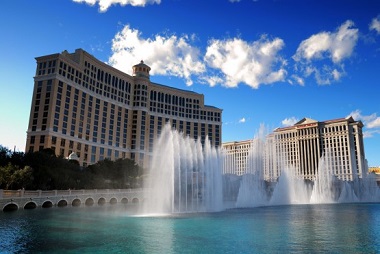Sin City Runs Dry: Drought in The Land of Fountains
 A couple hours before the light of dawn gilded the Vegas Strip, I turned on the shower in the hotel room I had called home for the last couple of days during the National Clean Energy Summit, only to watch the tub fill with tepid, muddy grey water. It smelt faintly of clay and was about as alluring to me as the idea of laying out by the pool in 104 degree weather had been the day before. While not quite what I had been hoping for, the silty soup in the bathtub was oddly comforting — probably what water in the desert really looks like, despite what the sparkling Bellagio Fountains next door might lead you to believe.
A couple hours before the light of dawn gilded the Vegas Strip, I turned on the shower in the hotel room I had called home for the last couple of days during the National Clean Energy Summit, only to watch the tub fill with tepid, muddy grey water. It smelt faintly of clay and was about as alluring to me as the idea of laying out by the pool in 104 degree weather had been the day before. While not quite what I had been hoping for, the silty soup in the bathtub was oddly comforting — probably what water in the desert really looks like, despite what the sparkling Bellagio Fountains next door might lead you to believe.Patricia Mulroy, Southern Nevada Water Authority General Manager, had told me the day before in the hallway after Arnold Schwarzenegger’s security team had kicked us out of the summit speakers’ greenroom, that the biggest misconception people had about Las Vegas was that the strip uses all the water.
“They see the fountains, they see the water displays and they say oh what a waste of water,” said Mulroy. “But the entire Las Vegas strip, which is the largest employer in the state of Nevada, bar none, uses just three percent of the water, that’s it. “
Mulroy would be the last person, however to tell you that there aren’t water issues in this part of the country. She’s proud of SNWA’s 200 million dollar investment to remove residential turf in the area, which allowed them to cut water use down by one third, to just 75 gallons of water per person per day in the area.
But in her words, “climate change keeps me up at night.”
“I stopped talking about it because it wasn’t worth engaging in the religious argument,” she said. “I would rather move forward, use it as our planning tool and start making the changes that need to happen. Someone else can have the religious argument, I am a pragmatist. Engaging in that is a huge distraction and I don’t have that kind of time to waste.”
SNWA is in the process of constructing a third intake pipe into Lake Mead, which supplies Las Vegas with ninety percent of its drinking water. The three year, 800 million dollar project is in response to record low water levels in the Colorado River’s largest reservoir. At least one of the two existing pipelines is close to useless at this point. The new third intake will tap the deepest part of the reservoir and is scheduled to be completed just months before the highest intake runs dry. The water level in Lake Mead has fallen 200 feet since the current 13-year drought started. Unless something like Noah’s flood repeats itself, by the end of the month, the total amount of water stored on the Colorado will reach the lowest point since Glen Canyon Dam started to fill Lake Powell in 1966.
“There’s a new normal all over the west,” said Mulroy. “Expenses around water are becoming more and more pronounced. The drought has hit southern Nevada economically as severely as anywhere.”
Mulroy has called on the government to release federal disaster aid money. By fall 2014, Lake Mead is expected to drop to 1,075 feet above sea level, a level which will prompt federally mandated water suppply cuts to Nevada and Arizona
Mulroy claims, however, that the controversial 15 billion dollar pipeline project that would bring water from eastern rural Nevada, to Vegas, is only the final option after all other possibilities on the Colorado have been exhausted.
When asked what were the other options on the river, however, Mulroy responded “that’s a good question.”
One scheme currently under consideration is to pay farmers to fallow their fields and divert the irrigation water back into Lake Mead.
“Climate change, to me, is a dark tunnel,” said Mulroy. “The rear view mirror doesn’t do you any good, what’s happened in the past, is no indicator of what is going to happen in the future. Everything has changed, and we don’t have much to go on.”
You can return to the main Market News page, or press the Back button on your browser.

